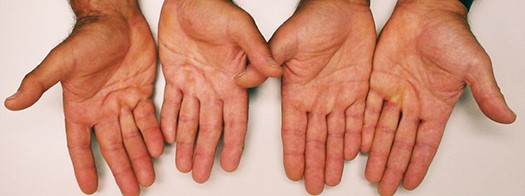These fibrotic changes can range from mild, without any limitation, to severe, where hand function is noticeably affected. Initially, nodules form in the palm. Band and cords then may form in the hand, causing of the first two joints in the digits (metacarpal phalangeal-MP-and proximal interphalangeal-PIP- joints) to bend inward. This bending is known as a flexion contracture and in Dupuytren’s disease, is most often observed in the ring and small fingers. Passive stretching and pre-surgical splinting alone have been shown to not have significant effect on improving these contractures and therefore, hand function. Once the hand becomes limited with daily life, evaluation by a hand surgeon is necessary.
There are several interventions available and the hand surgeon chooses the appropriate treatment depending on severity of contractures, location of contractures as well as other considerations, such as other co-morbid diseases. Open fasciotomy has been the standard treatment for Dupuytren’s contractures but it is also the most aggressive. The surgeon opens the palm and/or digit and uses a scalpel to physically release the cords causing the deformity. In a closed aponeurotomy, the surgeon uses a needle to manipulate and weaken the cord. Although there is less complication and an expedited recovery with the needle aponeurotomy, studies show the contracture recurrence after one year is twice as high (10-20% compared to 5-10%), with the PIP joint most affected. Collagenase, an injected enzyme which breaks down palmar collagen, is showing promise as an alternative to these two previous interventions, but since it’s new to the market, more research is needed. Following each of these procedures, the surgeon may elect for splinting, where a skilled hand therapist fabricates a custom orthosis to maintain the released joints straight post-operatively and may recommend nighttime splinting for several months. It is also common to have limited ability to fully grasp and form a fist following these procedures, and a formal exercise program established by a hand therapist can also help regain motion.

Although millions of people are living with Dupuytren’s disease worldwide, there is no prevention or cure available. Because Dupuytren’s is a disruption in the scarring process and is considered a systemic disease, any intervention that limits the formation of scarring with Dupuytren’s will ostensibly affect the entire body’s ability to heal. At this time no biomarker has been found, meaning a simple blood test cannot indicate current or future Dupuytren’s contractures; instead, physical changes are the primary means of diagnosing.
- Moorhart, M (2015). Pearls and pitfalls of needle aponeurotomy in Dupuytren’s disease. Plastic Reconstructive Surgery. March 153(D): 817-825.
- (No author) (2013). Needle or open fasciotomy for Dupuytren’s contracture: A review of the comparative efficacy, safety, and cost-efffectivness-An Update. Canadian Agency for Drugs and Technologies in Health.
Additional information obtained from the Dupuytren’s Foundation website.
If you have Dupuytren’s Disease or think you might, schedule a complimentary injury screen with one our hand therapists today.


1 Comment
Jeremy Madvin
Thanks for this clear overview of Dupuytren’s Disease. It’s amazing how something that starts in the hand can affect so much of what we do every day.